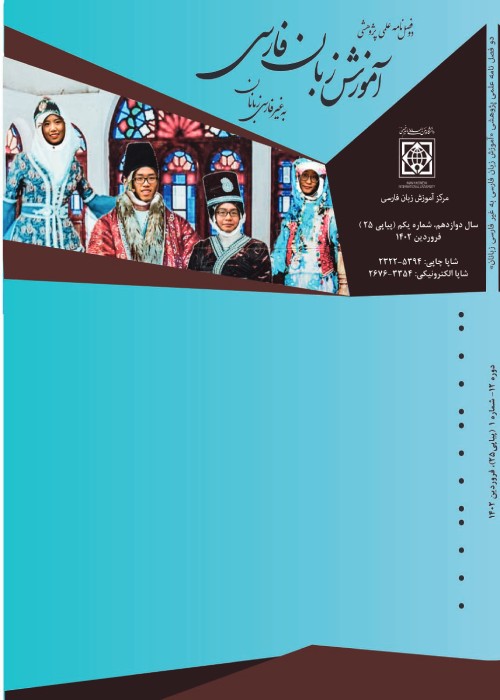Design and Validation of the First Persian Placement Test Based on the Educational Resources of Al-Mustafi (PBUH) Center for Teaching Persian to Non-Persian Speakers
Testing has always been an inseparable part of teaching. Having a test to determine the level of proficiency for Persian language teaching non-Persian speakers (Azfa) centers is a necessity. To this purpose, the first placement test based on the Persian language teaching textbooks of Al-Mustafa was designed and validated. The purpose of the present research was to design a standard test to determine the language proficiency level of the Persian language learners (beginner, intermediate, and advanced) based on "Parsa" textbooks. The participants were 135 Persian learners from Al-Mustafi (PBUH) Center for Teaching Persian to Non-Persian Speakers from four different nationalities studying in Iran and Turkey. The participants were recruited based on convenience sampling. The designed placement test included vocabulary and grammar, listening, reading, writing and speaking. The item analysis of the test was calculated using item difficulty and item discrimination formulas and the results showed that both the difficulty and discrimination levels were acceptable. The face and content validities were analyzed and confirmed using a written interview with 20 teachers of Al-Mustafa Center for Teaching Persian to Non-Persian Speakers. The inter-rater reliability (Cohen’s Kappa) between the evaluators’ scores for the speaking and writing sections of the test also indicated an acceptable agreement. Finally, the reliability of the tests was calculated using KR-21, and the reliability results of all three tests were above 80%, which shows the suitability of the tests.
Language testing is an inseparable part of language teaching. Through language assessment and evaluation, educators can determine whether the learner has successfully achieved the learning outcomes. A language test is an instrument which measures the quality and performance of a language program and educational resources. Tests are of different types and one of the most important tests is the placement test which helps educational institutions to place a learner in the right class or group based on the learner’s language knowledge and proficiency (Farhady et al., 2014; Bachman & Palmer, 2010). There is no doubt that the more standard the test, the more successful the language program. Therefore, it is of the utmost importance to design and validate language proficiency tests in order to assign learners to the right classes (Farhady et al., 2014) and help remove their psychological barriers (Kim & Shin, 2006). The present study is focused on designing and validating a placement test based on Al-Mustafi (PBUH) Center for Teaching Persian to Non-Persian Speakers’ Persian textbooks. Al-Mustafi (PBUH) Center for Teaching Persian to Non-Persian Speakers was established around 30 years ago and has over 60 branches around the world.
Past literature has focused on the design and validation of English placement tests (Akhidenor-Bamidele, 2019; Kadwa & Sheik, 2021; Kim & Shin, 2006; Nasem & Mohammad, 2018) and has highlighted the importance of using such tests to group learners. Persian proficiency tests (Abbassi, 2014; Ghonsooly, 2003; Zandi et al., 2020;) and placement tests (Sahraei & Rezapour, 2011) have also been the focus of some research, but to the best of the authors’ knowledge, no study has been conducted on designing and validating a placement test for Al-Mustafi (PBUH) Center for Teaching Persian to Non-Persian Speakers. This was the research gap that motivated the authors to focus on designing such a test for the three language proficiency levels of elementary, intermediate, and advanced. The research questions for the present research focused on the item analysis, reliability and validity of the designed placement test.
The designed tests contained 40 questions on vocabulary, grammar, reading, and listening. Also, two writing tasks were considered for the writing section. Finally, 10 oral questions were used for the speaking section of the test. Two raters scored the writing and speaking sections individually. Item analysis was used to analyze all multiple choice items on the tests. Also, in order to check the inter-rater reliability for the speaking and writing sections of the test, Cohen’s Kappa was used. SPSS version 26 was used for calculating the Kappa. The reliability of the tests was analyzed through KR-21 and teacher feedback (written interview) was collected for the face and content validities. After taking all teacher comments and suggestion on board, the test was ready to be administered. A total of 135 Persian language learner participants were recruited from the three language proficiency levels. The participants were from Pakistan, India, Azerbaijan, and Turkey. The test was administered both in Iran and Turkey. The 90 participants studying in Iran were all females and their age range was 18-25 (SD=1.62) and the 45 participants studying in Turkey were 25 females and 15 males and their age range was 13-47 (SD= 9.15). The teacher participants who took part in a written interview included 15 females and 5 males. Their ages ranged between 25 and 58 (SD=7.92) with a 4-18 years of teaching experience. All participants signed a written consent form.
The internal consistency of the designed test items was measured through Cronbach’s alpha. Cronbach’s alpha reliability coefficient normally ranges between 0 and 1. The closer the coefficient is to 1, the more internally consistent the test items. The reliability coefficient results for the three placement test levels revealed 0.94 for the beginner level which was found to be highly reliable, 0.83 for the intermediate level which indicates good internal consistency, and 0.80 for the advanced level which again indicates good internal consistency for the test items. The Kuder-Richardson 21 formula was also used to measure the internal consistency of the test items. All KR-21 results for the reliability showed acceptable results of over 0.7 (Dornyei, 2011; Farhady et al., 2014). Also, the inter-rater reliability results for the speaking and writing tasks of the tests were also considered acceptable. The inter-reliability was measured in order to measure the degree of agreement among independent observers. This was used to limit the subjective scoring of each rater. These results ranged from 0.69-0.91. The face and content validity of the tests were conducted through a written interview and the results showed that all teachers approved both the face and content validities. The only concern some teachers had was regarding the test time. For the beginner level, 10% of the teachers, and five percent of the teachers for the intermediate level test believed that the time should be increased by five minutes. The item analysis results also indicated that for the beginner level out of the 40 items, 39 items had acceptable difficulty levels and all 40 items enjoyed an acceptable discrimination level. For the intermediate level test, out of the 40 items, 32 items were considered to have acceptable difficulty levels and 8 items were considered difficult. 38 of the items also showed an acceptable discrimination level. Finally, for the advanced proficiency level, out of the 40 items, 38 items had an acceptable range and 2 items were considered to be simple. One reason for this simplicity might have been the shared interlingual lexicon since most advanced level participants were from Pakistan. The discrimination level for 39 of the advanced level test items was considered to be acceptable as well. All in all, it seems that the designed test was generally dominated by acceptable items. Also, most of the question items could successfully discriminate between high and low students. The overall face and content validities were also approved by the teachers and the reliability was approved through KR-21.
The present study aimed to design and validate a placement test based on Al-Mustafi (PBUH) Center for Teaching Persian to Non-Persian Speakers’ Persian textbooks. This was the first validated placement test to be designed for the Al-Mustafi (PBUH) Center for Teaching Persian to Non-Persian Speakers. The results revealed that the designed test for all three proficiency levels were considered acceptable. The internal consistency of the designed test items, measured through Cronbach’s alpha and KR-21 were considered reliable and also Cohen’s Kappa values showing the results for the inter-rater reliability measurement, ranging from 0.69-0.91, were considered very good to excellent. As for the validity of the placement tests, the results for the face validity and content validity of the tests, conducted through a written interview with teacher participants at all three proficiency levels (beginner, intermediate, and advanced), indicated an overall approval. The teachers’ suggestions regarding the time limit on the test for each level was also taken into consideration. The item analysis results including both item difficulty and item discrimination also showed acceptable levels for the test items. In the end the authors hope that the designed placement test could be used at Al-Mustafi (PBUH) Centers for Teaching Persian to Non-Persian Speakers worldwide and that this instrument could help both teachers and learners alike to have a better learning experience.
This paper and the research behind it would not have been possible without the exceptional support from Al-Mustafi (PBUH) Center for Teaching Persian to Non-Persian Speakers in Istanbul and Mashhad.
Conflict of Interest
- حق عضویت دریافتی صرف حمایت از نشریات عضو و نگهداری، تکمیل و توسعه مگیران میشود.
- پرداخت حق اشتراک و دانلود مقالات اجازه بازنشر آن در سایر رسانههای چاپی و دیجیتال را به کاربر نمیدهد.




